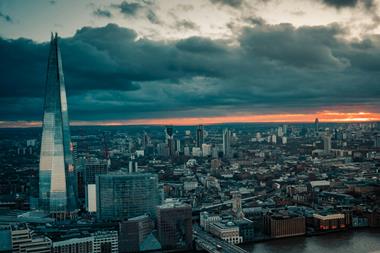The London market started to heat up about three years ago with an influx of institutional investors looking for a home in which to generate extra alpha returns. The West End and the City seemed like perfect stomping grounds. Business across a wide range of sectors was and still is booming thanks to a thriving economy. At the same time, levels of property development were and continue to be at record lows. There was very little construction of new buildings in the wake of the property fallout in the early 1990s and the stock market crash 10 years later. It was a classic case of demand outstripping supply according Kevin Aitchison, head of head of ING Real Estate's tailored accounts team.
The result of all the institutional investor attention has meant that yields are now bumping along the bottom while rents have seemingly gone through the roof. According to industry estimates, the City and West End office sector experienced the fastest rate of yield compression, dropping to 4%, and 4.5% to 5%, respectively from 6% to 7% two years ago.
As for rental growth, a second quarter report from Cushman and Wakefield, a global real estate service firm, notes that limited supply continues to drive rental values in London. Prime rents jumped to £95/ft2 (€1,525/m2) in the West End, a 19% hike from the start of 2006, while a premier building in the heart of the area - Hanover Square - fetched a record £100/ft2. Overall, the West End experienced a 20.8% rise in rental growth over the year to June 2006.
The City was not too far behind, ratcheting up year-on-year growth of 15.3% with prime rents increasing by £5 to £55/ft2. Although this figure may sound impressive, it is still below the peak of £65 seen in 2001 which suggests, according to analysts, that potential is still there to be tapped.
In terms of international comparisons, a first quarter ranking of 50 global markets by CB Richard Ellis, an international global real estate services firm, shows the West End office market at the top of the property league table. Factoring in the total cost of rent, taxes and service, the area came in at a hefty $185.60ft2 (€1,588/m2) annually followed by Tokyo's Inner Central submarket, with an estimated cost of $130 and the City of London, at $127.49ft2.
Michael Clarke, head of property distribution at Schroder Property Investment Management, believes that in Europe, the best bets are Stockholm and Helsinki because their economies are still going strong but the property development has not kept pace. Paris is equal to London in terms of the returns investors can expect while Amsterdam and Frankfurt should be avoided due to their significant oversupply situations.
leagueAlthough London is predicted to be a strong performer for the rest of the year and into 2007, the Bank of England's rate hike to 4.75% from 4.5% in the summer did cast a pall over the market. Although the Bank kept rates steady in its October meeting, analysts are worried that there might be another rise later in the year to keep inflation in check. This coupled with a general concern over slowing global economic growth is making investors, particularly at the top end, exert more caution.
This might explain why Shell-Mex House, a landmark building on the Strand, with a hefty £550m price tag, is still on the market. All eyes are also on the prospects for the famous Gherkin building in the City, which has just gone on the block for £600m, as well as property tycoon Simon Halabi's £1.8bn portfolio of properties which includes the Aviva Tower and Bankside estate, both going for £400m.
Robin Goodchild, director of European strategy at LaSalle Investment Management in London, says: "London is performing very well and the strength of the financial service industry is its bedrock but history shows property markets can't be red hot forever. This explains some of the nervousness in the market. We expect to see strong rental growth this year and next but the risk is that rents plateau thereafter and we could even have an oversupply situation."
Steve Mastrovich, a managing director in JP Morgan Asset Management's Real Estate group, echoes these sentiments. "London has made a strong recovery over the past two years. Yields are low and rents are high but the big question is how long will it last? A spigot of new construction has been turned on but ideally, you want to see two years of strong rental growth before it comes on stream. So far, we have only seen one."
A staggering 12mft of new office space is proposed to fill the capital's skyline between now and 2008. This represents about 6% of the just over 200m square feet of office space in London. Bill Hughes, head of real estate at RREEF UK, the real estate and infrastructure investment management arm of Deutsche Asset Management, says that "typically, property runs on a seven year cycle. The City only has one or two years left of its growth phase which means the new supply will be coming on board near the end of its growth cycle. As a result, investors may want to take a more opportunistic approach where value can be added in a relatively short space of time. This means looking at properties that are vacant, can be refurbished and relet within a one to two year period."
Industry experts also believe that prospects can also be unearthed in fringe areas such as Paddington, Camden, Hammersmith and mid-town which is between Clerkenwell and the West End. "There are opportunities in these areas, but before plunging in investors have to carefully evaluate the suitability for today's occupiers of buildings they are buying into. There are secondary properties which even after refurbishment are top tenant on a long lease term.These areas do attract many mid-sized professional firms as well as larger occupiers. For example, Hammersmith benefits from strong transportation links and is home to a good mix of tenants from corporates to several law, IT, surveyor and media firms," notes Anthony Shayle, head of business development and marketing at AXA Real Estate Investment Management UK.






























No comments yet